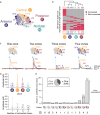Structured connectivity in the output of the cerebellar cortex
- PMID: 38982047
- PMCID: PMC11233638
- DOI: 10.1038/s41467-024-49339-1
Structured connectivity in the output of the cerebellar cortex
Abstract
The spatial organization of a neuronal circuit is critically important for its function since the location of neurons is often associated with function. In the cerebellum, the major output of the cerebellar cortex are synapses made from Purkinje cells onto neurons in the cerebellar nuclei, yet little has been known about the spatial organization of these synapses. We explored this question using whole-cell electrophysiology and optogenetics in acute sagittal cerebellar slices to produce spatial connectivity maps of cerebellar cortical output in mice. We observed non-random connectivity where Purkinje cell inputs clustered in cerebellar transverse zones: while many nuclear neurons received inputs from a single zone, several multi-zonal connectivity motifs were also observed. Single neurons receiving input from all four zones were overrepresented in our data. These findings reveal that the output of the cerebellar cortex is spatially structured and represents a locus for multimodal integration in the cerebellum.
© 2024. The Author(s).
Conflict of interest statement
The authors declare no competing interests.
Figures






References
MeSH terms
Grants and funding
- PJT-153150/Gouvernement du Canada | Instituts de Recherche en Santé du Canada | CIHR Skin Research Training Centre (Skin Research Training Centre)
- RGPIN-2022-03439/Gouvernement du Canada | Natural Sciences and Engineering Research Council of Canada (Conseil de Recherches en Sciences Naturelles et en Génie du Canada)
- Doctoral Fellowship/Fonds de Recherche du Québec - Nature et Technologies (Quebec Fund for Research in Nature and Technology)
- Doctoral Scholarship/Fonds de Recherche du Québec - Santé (Fonds de la recherche en sante du Quebec)
LinkOut - more resources
Full Text Sources
Molecular Biology Databases

